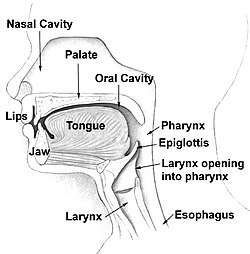Mouth: Difference between revisions
Undid revision 452842292 by 217.206.225.5 (talk) |
|||
| Line 46: | Line 46: | ||
===Function=== |
===Function=== |
||
The mouth plays an important role in [[sucking]] (it is part of the [[sucking apparatus]]), [[facial expression]], [[eating]], [[drink]]ing, and [[breathing]]. |
The mouth plays an important role in [[sucking]] (it is part of the [[sucking apparatus]]), [[facial expression]], [[eating]], [[drink]]ing, and [[breathing]]. |
||
[[Infant]]s are born with a [[sucking]] reflex, by which they [[instinct]]ively know to suck for nourishment using their lips and [[jaw]]. |
[[Infant]]s are born with a [[sucking]] reflex, by which they [[instinct]]ively know to suck for nourishment using their lips and. it is also know to be used for mastication and to lubricate food[[jaw]]. |
||
===Cultural aspects=== |
===Cultural aspects=== |
||
Revision as of 08:44, 28 September 2011
This article needs additional citations for verification. (June 2008) |
| Mouth | |
|---|---|
 Head and neck. | |
 A closed human female mouth | |
| Details | |
| Identifiers | |
| Latin | os, cavitas oralis |
| MeSH | D009055 |
| TA98 | A05.1.00.001 |
| TA2 | 119, 2774 |
| FMA | 49184 |
| Anatomical terminology | |
The mouth is the first portion of the alimentary canal that receives food and saliva.[1] The oral mucosa is the mucous membrane epithelium lining the inside of the mouth.
In addition to its primary role as the beginning of the digestive system, in humans the mouth also plays a significant role in communication. While primary aspects of the voice are produced in the throat, the tongue, lips, and jaw are also needed to produce the range of sounds included in human language. Another non-digestive function of the mouth is its role in secondary social and/or sexual activity, such as kissing.
The mouth is normally moist, is lined with a mucous membrane, and contains the teeth. The lips mark the transition from mucous membrane to skin, which covers most of the body.
In Humans
Mouth cavity

The first space of the mouth is the mouth cavity, bounded laterally and in front by the alveolar arches (containing the teeth), and posteriorily by the isthmus of the fauces. The oral cavity is also known as the mouth which swallows food and drinks that then go down the esophagus and into the stomach.
Function
The mouth plays an important role in sucking (it is part of the sucking apparatus), facial expression, eating, drinking, and breathing. Infants are born with a sucking reflex, by which they instinctively know to suck for nourishment using their lips and. it is also know to be used for mastication and to lubricate foodjaw.
Cultural aspects
According to Western etiquette, the mouth is kept closed, especially when chewing.
Lips can be adorned with lipstick or lip gloss, although in most cultures this is typically only practiced by females. Both men and women, however, apply lip balm in order to soothe chapped or dry lips.
Piercings in or around the mouth have been made popular by younger generations, including those on the lip or tongue. The uvula piercing, while increasing in popularity, remains relatively rare.
Development
The philtrum is the vertical groove in the upper lip, formed where the nasomedial and maxillary processes meet during embryo development. When these processes fail to fuse fully, a hare lip and/or cleft palate can result.
The nasolabial folds are the deep creases of tissue that extend from the nose to the sides of the mouth. One of the first signs of age on the human face is the increase in prominence of the nasolabial folds.
In non-human animals

Some animal phyla, including vertebrates, have a complete digestive system, with a mouth at one end and an anus at the other. Which end forms first in ontogeny is a criterion used to classify animals into protostome and deuterostome. The first space of the mouth is the mouth cavity, bounded laterally and in front by the alveolar arches (containing the teeth), and posteriorly by the isthmus of the fauces.[1]
See also
- Head and neck anatomy
- Mouth breathing
- Index of oral health and dental articles
- List of basic dentistry topics
- Tonsillolith
- Arthropod mouthparts
- Insect mouthparts
